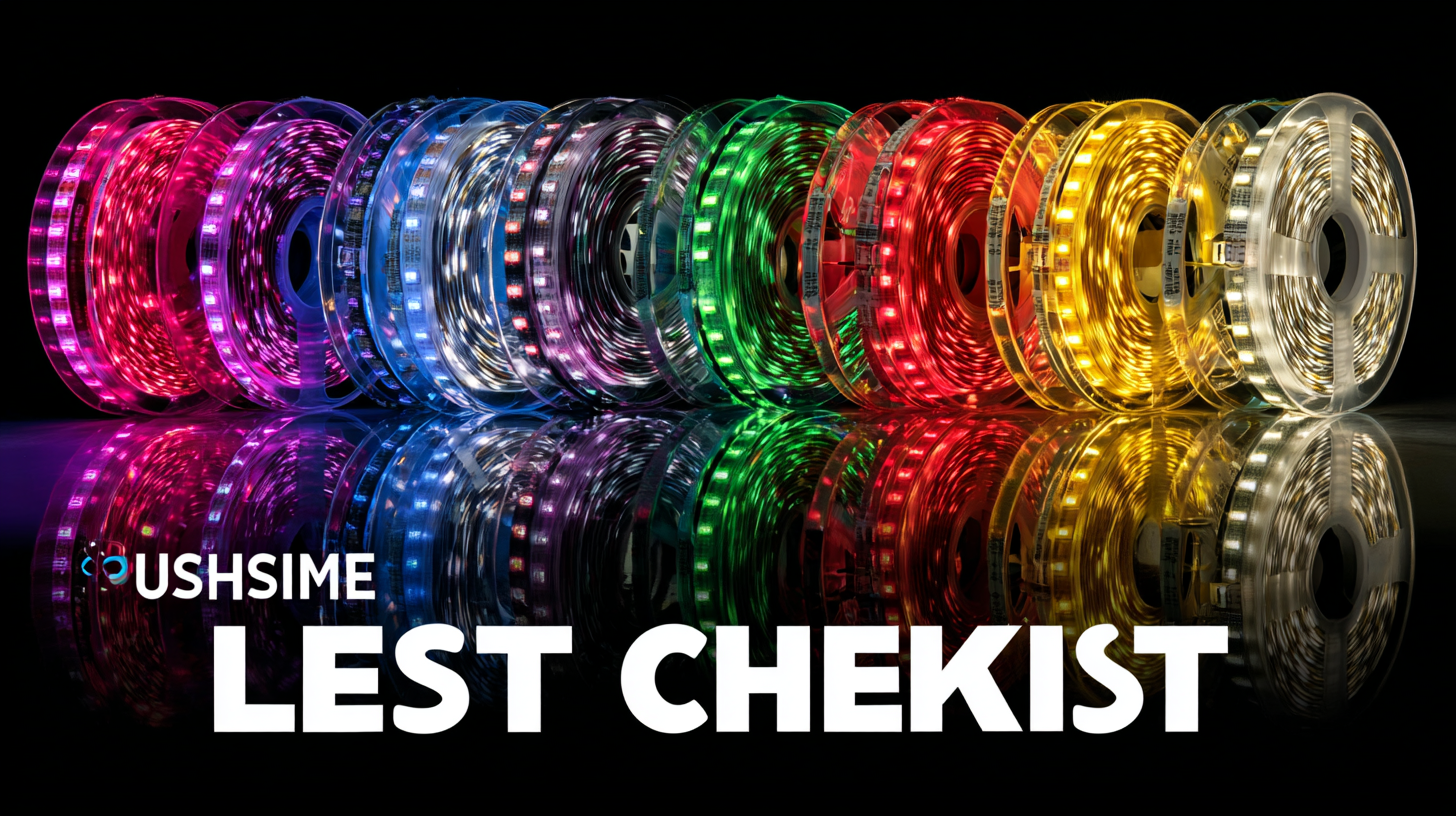Edison LED Lighting
Projects
Ultimate Guide to Sourcing High-Quality LED Strip Lighting Suppliers: Essential Checklist and Industry Insights
As the popularity of LED strip lighting continues to soar in both residential and commercial settings, sourcing high-quality suppliers has become essential for projects that demand durability, aesthetic appeal, and energy efficiency. This ultimate guide aims to equip you with a comprehensive checklist of vital considerations while exploring the vast landscape of LED strip lighting suppliers.
 From understanding the various types available in the market to evaluating their credibility and product offerings, we'll share industry insights that will enhance your sourcing strategy.
Whether you're an interior designer, contractor, or DIY enthusiast, our guide will help you navigate the intricate details of LED strip lighting procurement, ensuring you make informed decisions that lead to stunning, long-lasting results.
Join us on this journey as we unravel the key elements to look for when selecting the perfect LED strip lighting suppliers for your needs.
From understanding the various types available in the market to evaluating their credibility and product offerings, we'll share industry insights that will enhance your sourcing strategy.
Whether you're an interior designer, contractor, or DIY enthusiast, our guide will help you navigate the intricate details of LED strip lighting procurement, ensuring you make informed decisions that lead to stunning, long-lasting results.
Join us on this journey as we unravel the key elements to look for when selecting the perfect LED strip lighting suppliers for your needs.
Understanding the Importance of High-Quality LED Strip Lighting for Your Projects
High-quality LED strip lighting is becoming an essential component in both residential and commercial projects, a trend reflected in the global market growth. According to a report by MarketsandMarkets, the LED lighting market is projected to reach $128.8 billion by 2027, growing at a CAGR of 13.2% from 2022. This trend is primarily driven by the increasing adoption of energy-efficient lighting solutions, as LED strips consume significantly less power compared to traditional lighting methods. For instance, LED strip lights can use 75% less energy, which not only contributes to sustainability efforts but also reduces operational costs.
Furthermore, the versatility of high-quality LED strip lighting is unparalleled. They can be used for various applications, from accent lighting in homes to complex installations in commercial spaces. Research indicates that almost 40% of architects and designers prefer LED strips for their aesthetic appeal and flexibility in design. High-quality strips also ensure longevity and consistent performance, reducing maintenance needs and enhancing the overall value of the project. It's evident that investing in superior LED strip lighting is not merely about illumination—it's about creating impactful spaces that resonate with modern design principles and sustainability goals.
Key Factors to Consider When Sourcing LED Strip Lighting Suppliers
When sourcing high-quality LED strip lighting suppliers, there are several key factors to consider to ensure optimum quality and performance. First, evaluating the supplier's certifications is paramount—looking for standards such as ISO 9001 and RoHS compliance goes a long way in establishing reliability. According to a recent industry report by MarketsandMarkets, the global LED strip lighting market is projected to reach USD 10.2 billion by 2025, highlighting the importance of partnering with suppliers who maintain high production standards to stay competitive.
Another crucial consideration is the materials used in manufacturing LED strips. An informed supplier will provide details about their materials, such as the type of LED chips and PCB used, which can significantly influence brightness, durability, and energy efficiency. "The right materials can increase the lifespan of the product by up to 30%, according to LEDinside," making it essential to prioritize suppliers who invest in high-grade components.
**Tips:** Always request samples before finalizing a supplier to assess color consistency and luminosity. Additionally, consider suppliers that offer excellent after-sales service to handle any issues promptly, which is often a sign of a reputable company. Remember to compare at least three different suppliers to ensure competitive pricing while not compromising on quality.

Essential Checklist for Evaluating Potential LED Strip Lighting Suppliers
When sourcing high-quality LED strip lighting suppliers, it’s crucial to have a robust checklist to evaluate potential partners effectively. Start by assessing the supplier’s reputation in the industry. Look for online reviews, testimonials, and case studies that showcase their track record. Engaging with other businesses that have collaborated with the supplier can provide valuable insights into their reliability and product quality.
Next, consider the variety and quality of the products on offer. A reputable LED strip lighting supplier should provide a wide range of options, including different colors, brightness levels, and lengths. Additionally, ensure that the products comply with industry standards and certifications, such as CE or RoHS, which indicate safety and environmental compliance. A commitment to innovation and the use of advanced technology in their manufacturing processes can also be an indicator of a supplier’s quality.
Lastly, evaluate the supplier's customer service and support. Effective communication, timely responses, and helpful service can significantly enhance your experience. Look for suppliers who offer detailed product information and have a responsive customer service team ready to address any concerns. Establishing a strong relationship with a supplier who prioritizes customer satisfaction can pave the way for successful long-term collaboration.
Industry Insights: Trends in LED Strip Lighting Manufacturing and Sourcing
The LED strip lighting industry has witnessed remarkable growth, driven by increasing demand for energy-efficient and versatile lighting solutions. According to a recent report by ResearchAndMarkets, the global LED lighting market is projected to reach $160 billion by 2025, with a compound annual growth rate (CAGR) of 13.6% from 2020 to 2025. This trend underscores the shift towards LED technologies that optimize energy consumption while offering enhanced design flexibility.
Moreover, sustainability remains a key focus within the sourcing landscape. As manufacturers pivot towards environmentally friendly production methods, the proliferation of smart technologies integrated within LED products has become evident. A survey conducted by the U.S. Department of Energy revealed that smart LED lighting systems could reduce energy use by up to 75% compared to traditional lighting. This transition not only supports global sustainability goals but also aligns with consumer preferences for eco-friendly products. Hence, when sourcing high-quality LED strip lighting suppliers, it is crucial to consider their adherence to sustainable practices and technological innovations to stay ahead in this dynamic market.
Building Long-Term Relationships with Your LED Strip Lighting Suppliers
Building long-term relationships with your LED strip lighting suppliers is crucial for ensuring a steady flow of high-quality products and services. Establishing trust and open communication from the outset can create a solid foundation. It is important to engage with suppliers regularly, discussing not only current orders but also future needs and market trends. This proactive approach fosters collaboration, allowing both parties to align their goals and expectations over time.

Additionally, showing appreciation for your suppliers can strengthen the partnership. Simple gestures, such as prompt payments, constructive feedback, or recognition of their contributions to your projects, can go a long way. By investing time in these relationships and treating suppliers as partners rather than mere vendors, businesses can secure better terms, exclusive access to new products, and improved service—all of which are vital for maintaining a competitive edge in the LED lighting industry. Ultimately, a commitment to nurturing these connections will lead to mutual growth and success.
